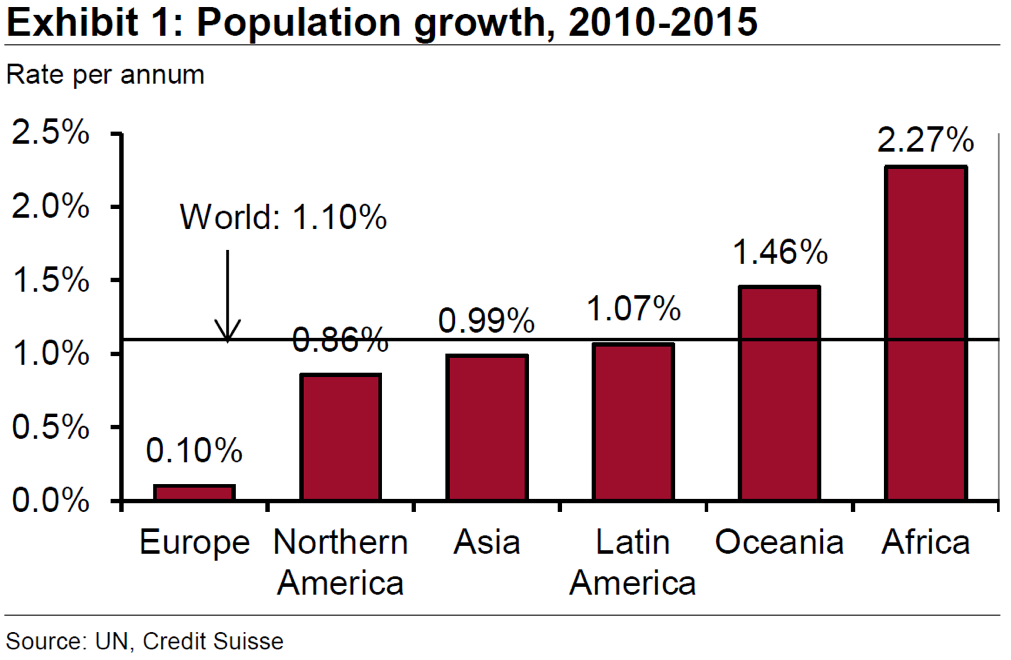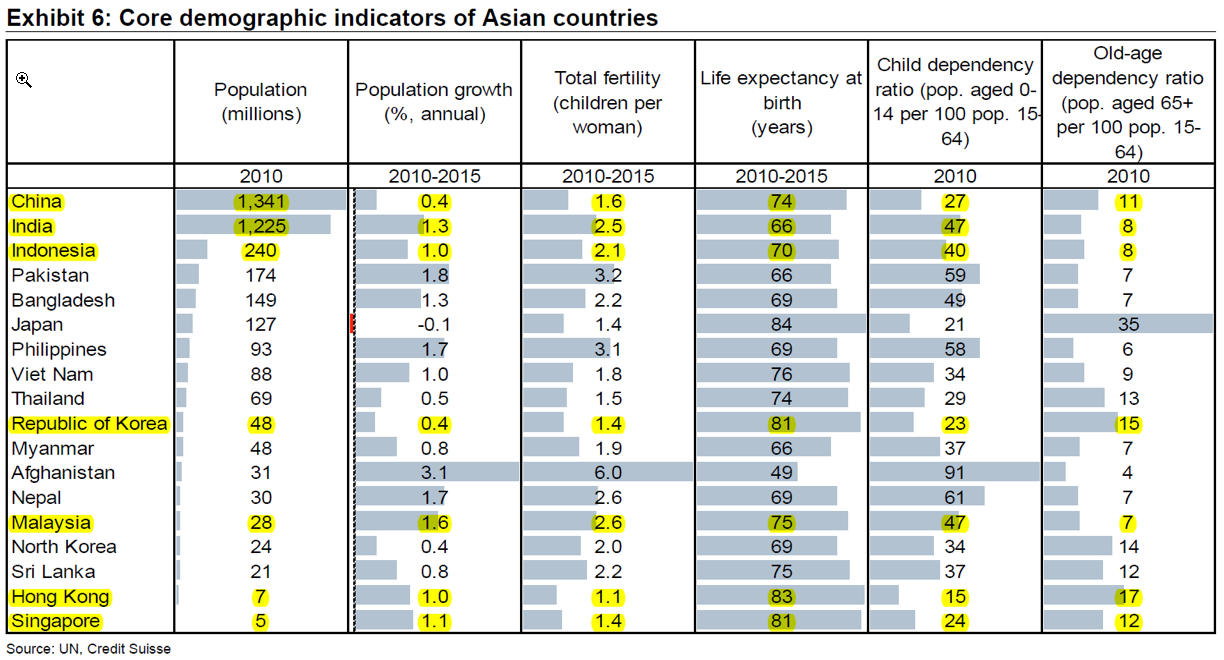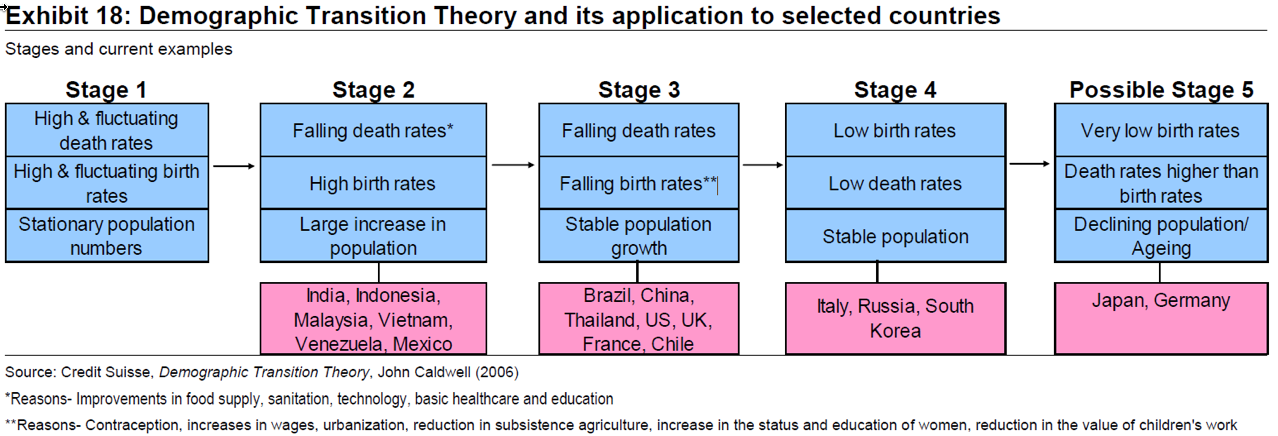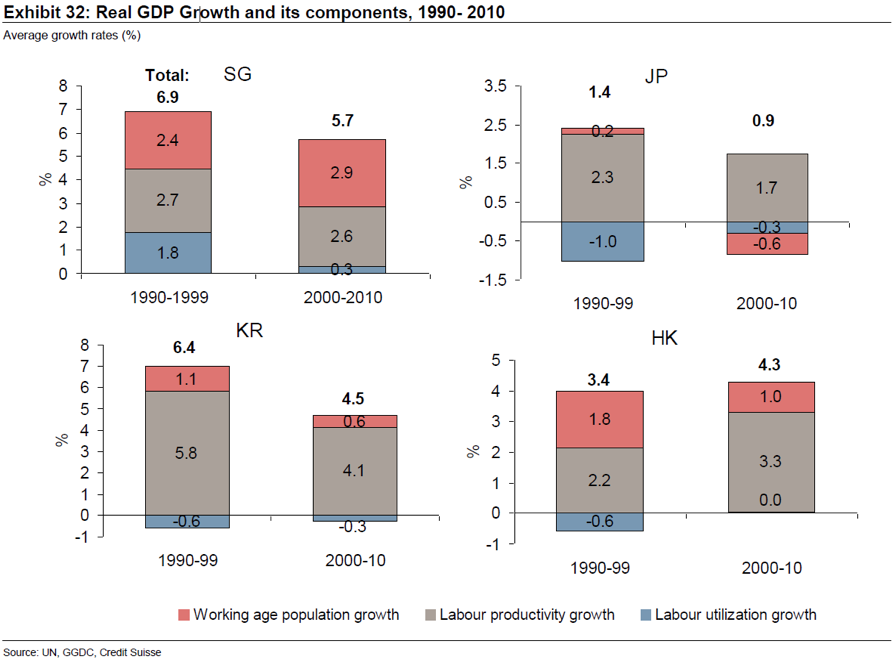Hitting its peak in 1965-1970, the population in Asia skyrocketed at 2.5% at annum, outpacing the rest of the world in growth. Today, Asia is home to 60% of the world's total population, or roughly 4.2 billion people. Rapid growth in its population in the past signaled that Asia was and still is a place with consumer growth and market potential.
In the past few decades, however, the population growth in Asia has slowed, which led to rapid ageing of demographics across Asian countries. Meanwhile, labor force growth in Asian has also decreased below the world average.
Across eight major economies in Asian, the downward pattern in population growth is obvious. According to Credit Suisse Research team in Assessing Asia’s Demographic Promise: “For our detailed demographic analysis, we selected eight Asian countries/economies that cover a wide spectrum in terms of population, labour force, economic development, social systems, etc. These are China (CN), Hong Kong (HK), India (IN), Indonesia (ID), Malaysia (MY), Japan (JP), Republic of Korea (KR), and Singapore (SG). Exhibit 7 presents population growth rates of the selected countries with Japan currently undergoing negative population growth and India and Malaysia experiencing slowing population growth over the last two decades.”
Due to the slowly growing population and ageing population, the old-age dependency ratio is increasing in the aforementioned eight major economies of Asia.
“Changes in fertility rates and mortality rates have led to changing population structures. The child dependency and old-age dependency ratios are two summary measures of the population age structure. In the definition used by the United Nations, child dependency ratio is the ratio of population aged 0-14 per 100 population aged 15-64, and old-age dependency ratio is the ratio of population aged 65+ per 100 population aged 15-64. These ratios reflect the number of dependents relative to the working age population. Exhibit 14 shows that the old-age dependency ratio is the highest in Japan in 2010, which makes it the oldest country in the world. Malaysia, India and Indonesia have low old-age dependency ratios. The traditional measures of dependency ratios, however, are becoming increasingly obsolete as youngsters today are spending more years in education and entering the labor force at later ages. That is, the appropriate age ranges for the working age population are shifting. As a thought experiment, we also calculate the old age dependency ratios using an alternative measure with those in the 20-64 age range as the working age population. It resulted in higher old-age dependency ratios, compared to the traditional measure”
Looking at the Demographic Transition Model, which represents the transition from high birth and death rates to low birth and death rates as a country advances from pre-industrial to industrialization, we can explain in more detail what changes in demographics are occurring to each group of nations in a similar industrial transition.
“According to this framework, different Asian countries are in different stages of the demographic transition. India, Malaysia, Indonesia and Vietnam -- the younger Asian countries are in stage two of falling death rates, high birth rates and increased population. China is in stage three of falling death rates and birth rates, while the Republic of Korea is in stage four of low birth rates and death rates. Japan is experiencing a stage where birth rates have become so low that they are lower than death rates, leading to a declining and aged population. The fact that Asian countries are in different stages of demographic transition has led to very different patterns of population growth, age structure and life expectancy in these countries.”
In changing demographics, it is crucial to understand how much working age population growth contributes to the overall GDP.
“…the contribution of working age population growth was very significant in explaining overall real GDP growth in Singapore during 1990- 2010 and in Hong Kong during 1990-1999. On the other hand, in Japan and the Republic of Korea, labour productivity growth contributed the most to real GDP growth in 1990-2010. In Japan, the working age population growth fell during 2000-2010 and dragged overall real GDP growth down. In the future, these ageing countries cannot rely much on working age population growth and will have to increase labour productivity growth.”
Demographics characteristics vary significant across countries in Asia. However, as shown above, the general trend is that birth rates are slowing down and consequently, the population is ageing more rapidly. Therefore, the challenge ahead of Asian economies is how to resolve the labor force dependency continuously shifting over to the older population. The solution will require a structural policy changes across pensions, education, labour market, etc.
Disclaimer
The above content is provided for educational and informational purposes only, does not constitute a recommendation to enter in any securities transactions or to engage in any of the investment strategies presented in such content, and does not represent the opinions of Bondsquawk or its employees.
- English (UK)
- English (India)
- English (Canada)
- English (Australia)
- English (South Africa)
- English (Philippines)
- English (Nigeria)
- Deutsch
- Español (España)
- Español (México)
- Français
- Italiano
- Nederlands
- Português (Portugal)
- Polski
- Português (Brasil)
- Русский
- Türkçe
- العربية
- Ελληνικά
- Svenska
- Suomi
- עברית
- 日本語
- 한국어
- 简体中文
- 繁體中文
- Bahasa Indonesia
- Bahasa Melayu
- ไทย
- Tiếng Việt
- हिंदी
Asia’s Changing Demogrphics
Published 10/05/2012, 03:26 PM
Updated 07/09/2023, 06:31 AM
Asia’s Changing Demogrphics
Latest comments
Loading next article…
Install Our App
Risk Disclosure: Trading in financial instruments and/or cryptocurrencies involves high risks including the risk of losing some, or all, of your investment amount, and may not be suitable for all investors. Prices of cryptocurrencies are extremely volatile and may be affected by external factors such as financial, regulatory or political events. Trading on margin increases the financial risks.
Before deciding to trade in financial instrument or cryptocurrencies you should be fully informed of the risks and costs associated with trading the financial markets, carefully consider your investment objectives, level of experience, and risk appetite, and seek professional advice where needed.
Fusion Media would like to remind you that the data contained in this website is not necessarily real-time nor accurate. The data and prices on the website are not necessarily provided by any market or exchange, but may be provided by market makers, and so prices may not be accurate and may differ from the actual price at any given market, meaning prices are indicative and not appropriate for trading purposes. Fusion Media and any provider of the data contained in this website will not accept liability for any loss or damage as a result of your trading, or your reliance on the information contained within this website.
It is prohibited to use, store, reproduce, display, modify, transmit or distribute the data contained in this website without the explicit prior written permission of Fusion Media and/or the data provider. All intellectual property rights are reserved by the providers and/or the exchange providing the data contained in this website.
Fusion Media may be compensated by the advertisers that appear on the website, based on your interaction with the advertisements or advertisers.
Before deciding to trade in financial instrument or cryptocurrencies you should be fully informed of the risks and costs associated with trading the financial markets, carefully consider your investment objectives, level of experience, and risk appetite, and seek professional advice where needed.
Fusion Media would like to remind you that the data contained in this website is not necessarily real-time nor accurate. The data and prices on the website are not necessarily provided by any market or exchange, but may be provided by market makers, and so prices may not be accurate and may differ from the actual price at any given market, meaning prices are indicative and not appropriate for trading purposes. Fusion Media and any provider of the data contained in this website will not accept liability for any loss or damage as a result of your trading, or your reliance on the information contained within this website.
It is prohibited to use, store, reproduce, display, modify, transmit or distribute the data contained in this website without the explicit prior written permission of Fusion Media and/or the data provider. All intellectual property rights are reserved by the providers and/or the exchange providing the data contained in this website.
Fusion Media may be compensated by the advertisers that appear on the website, based on your interaction with the advertisements or advertisers.
© 2007-2024 - Fusion Media Limited. All Rights Reserved.
